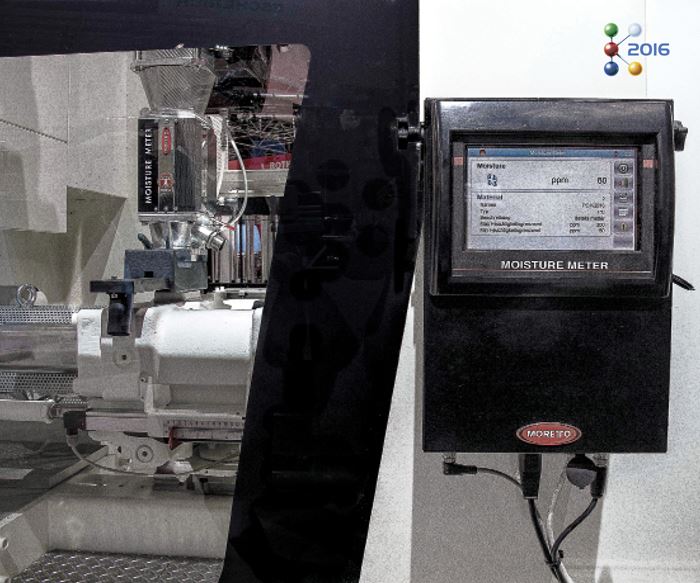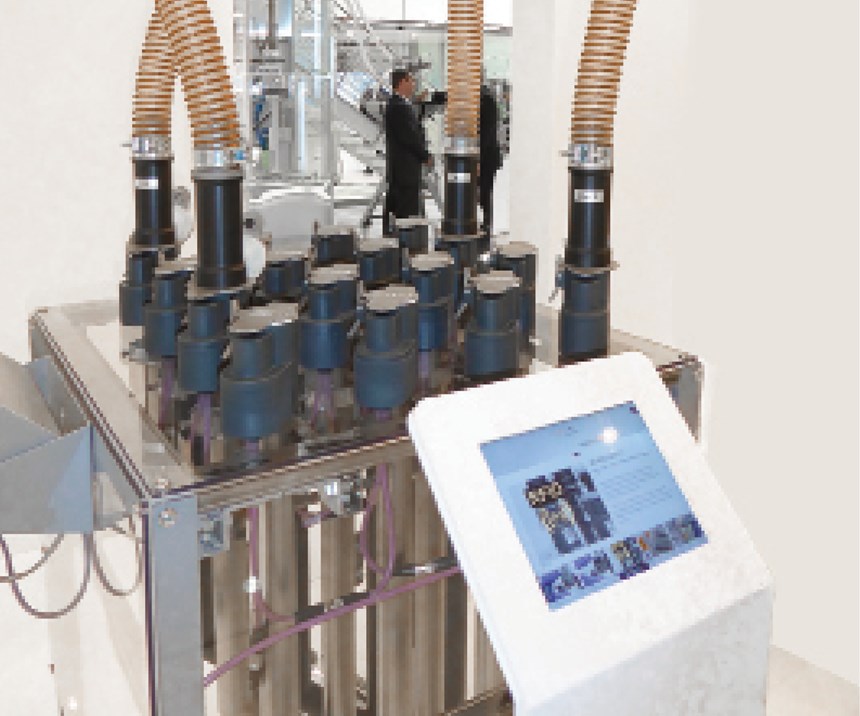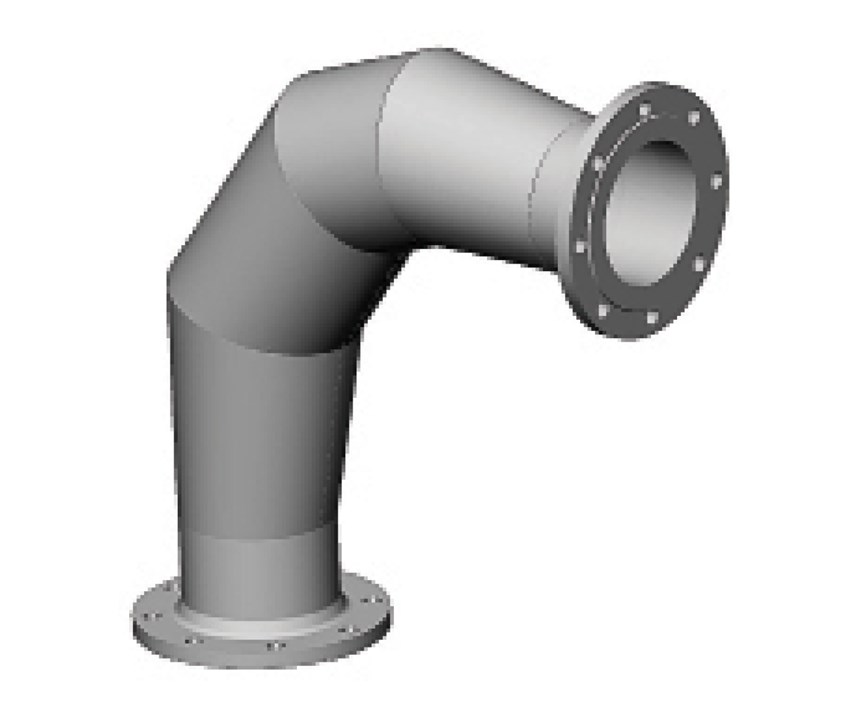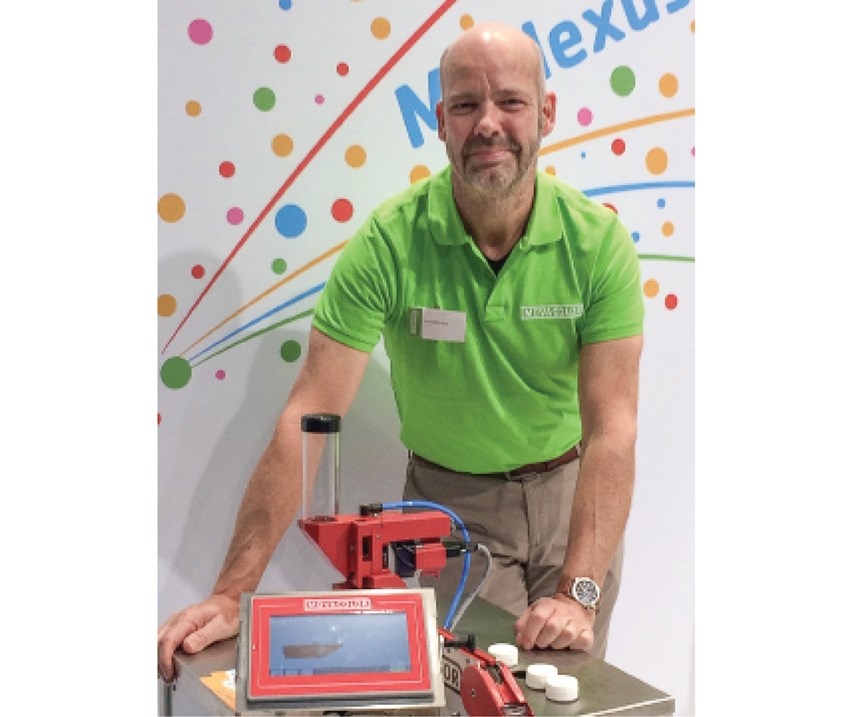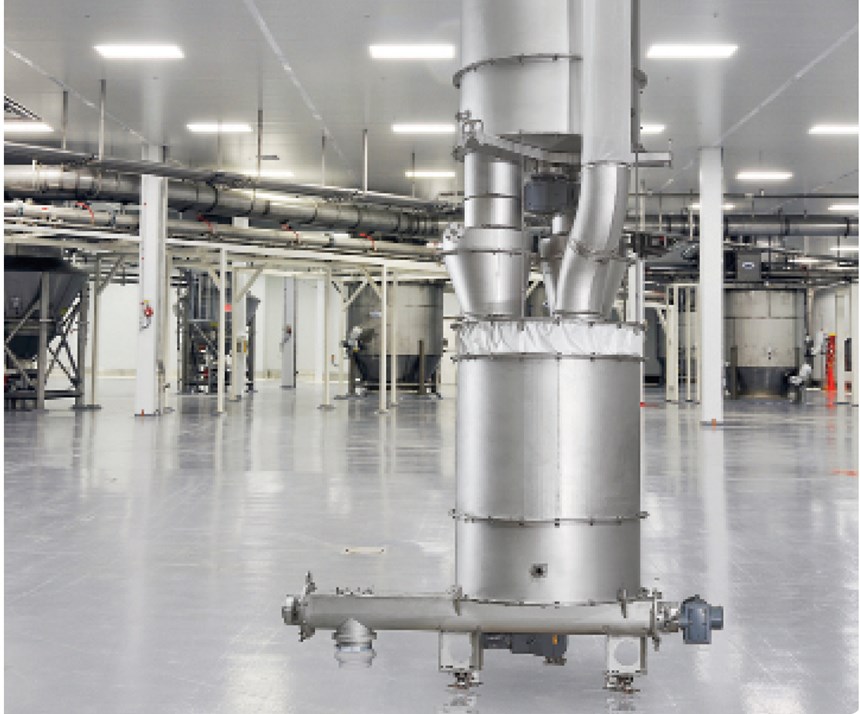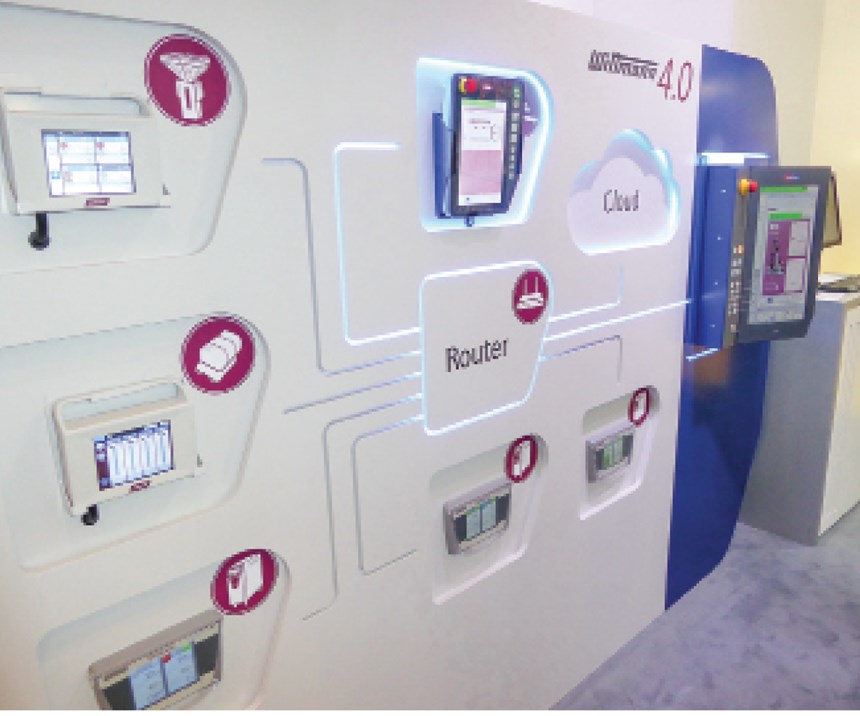Augmented Auxiliaries At K 2016
Incremental improvements to existing technologies combined with altogether new advances at the giant show.
Auxiliary equipment suppliers at K 2016 were as eager as many others to tie their show display to the Industry 4.0 buzz sweeping the show; and while for most the correlation was somewhat of a stretch, a handful brought truly connected products to Düsseldorf. In addition, beyond some incremental advances, suppliers took big steps forward in several new technologies, including inline moisture measurement for dryers, controlled conveying of materials, and extremely precise dosing. This article summarizes developments not previously featured in the September show preview, and new information on some previously mentioned products.
Italy’s Moretto (MORETTO USA LLC, Columbus, Ohio) showcased its Eureka Moisture Meter, an in-line, real-time moisture analyzer at K. The system, which reportedly features measuring accuracy down to ±3 ppm, samples the moisture levels inside plastic pellets at the base of the drying hopper every 2 sec.
Moretto says the patented measuring technology, dubbed Power Peak, determines moisture levels by sending electromagnetic waves through the resin, with the waves’ amplitude changing depending on the variations in moisture content. The Moisture Meter can measure water in resin down to 15 ppm, and it comes with a standalone controller, including 7-in. color touchscreen. Users select the material to be run, as well as the ppm range, from the device’s database of resins, which Moretto is working to expand. The control then sends the necessary parameters to the moisture meter for automatic configuration.
One controller can manage up to six Moisture Meter devices and connect wirelessly to a printer for hard-copy reports. The controller also has Ethernet and USB connections, and is compatible with MOWIS, Moretto’s modular control platform.
Two sizes of the Moisture Meter are available, the MMB 12 and MMB 22, with capacities ranging from 6 kg to 1500 kg/hr (13 lb to 3300 lb/hr). Installation options include above the machine’s feedthroat or below the dryer.
At the show, Gene Flockerzi, general manager for Moretto in North America, said there were 20 of the units in the field, with plans to be in North America soon. The technology should be of particular interest to markets like medical and automotive where process verification, including certification of the material’s moisture level, is required.
Danish firm Labotek A/S (distributed in the U.S. by ROMAX, INC., Louisville, Ky.), threw its hat into the inline moisture-measurement ring with the introduction of its Moist Control technology, which it says can be positioned below the dryer hopper or above the machine. Labotek officials said Moist Control borrows public technology from the concrete industry to measure moisture levels inline.
NEW BLENDING TECHNIQUE COUNTS PELLETS
Dutch firm and dosing-equipment specialist Movacolor displayed new technology for processors seeking to mix in less than 35 g/hr of special additives. Moving beyond volumetric and gravimetric technologies, Movacolor introduced what it called “optometric” dosing in a system that it says uses vision to count individual pellets with 100% accuracy.
Called the MCNexus, the ultra-compact system features a body that’s 3D-printed to include a built-in venturi chamber. Movacolor says 3D printing also allows custom sizing of the unit, which fits directly onto the flange of an extruder or injection molding press. The venturi is used to create a vacuum and suck up pellets as needed, which are than fed onto a dosing disc. The disc itself has small holes to hold the pellets, and an optical sensor ensures a pellet is present. The same venturi-generated air stream is then used to discharge the pellet. There are three discs available with holes measuring from 1 to 3 mm to accommodate different material sizes. Hopper volumes range from 500 to 1000 ml, with throughputs from 0 to 4 pellets/sec. A stepper motor positions the disc, which in injection could feed 3 pellets/shot, for instance, or request pellets multiple times per second in extrusion.
Movacolor used K 2016 to introduce the technology to the broader processing world and said there were 10 of the devices already in operation. Plans are in place to commercialize it by midyear at the latest. The device, which measures 200 mm long and 100 mm high, will target precision injection molding markets, including medical, automotive, and electronics, as well as low-rate extrusion.
SPECIALIZED FEEDING & BLENDING
Process Control Corp., Atlanta, introduced an enhanced line of its X-Series continuous gravimetric blenders for loss-in-weight dosing of liquid peroxides in crosslinked polyethylene (PEX-A) processes. The company says that compared with dosing volumetrically, gravimetric feeding allows liquid dosing of the peroxide in one common recipe, either in percent or parts per hundred, together with the bulk components used in the process. The blender also adapts to changes in extruder output, including at startup and shutdown, to ensure the recipe and extrudate remain in specification. Dosing rates can go down to 40 g/hr.
The blender is also outfitted to handle peroxide’s unique requirements, including special surface treatments for the gear pumps, stainless-steel construction for any surfaces that contact the liquid, and a “3D agitator” to better homogenize the bulk components and the liquid. The area that receives the peroxide also has a safety encapsulation, including thermal insulation, and all hoppers are purged with inert gas. The peroxide section is cooled via a water-to-gas heat exchanger.
Coperion K-Tron, Sewell, N.J., showed an Electronic Pressure Compensation (EPC) system for its high-accuracy loss-in-weight feeders. The main advantages of the new system include improved accuracy and reliability as well as lower initial cost and easier installation compared with traditional mechanical pressure-compensation systems. Coperion K-Tron has developed a clever but simple electronic solution for accurate and steady pressure compensation in feeder hoppers and outlets. The modular design incorporates pressure sensors and electronics tailored to interact smoothly with Coperion K-Tron’s KCM feeder control system. Retrofitting options for existing feeders are available. EPC can be installed on a majority of Coperion K-Tron gravimetric feeders.
For high-rate applications, Coperion K-Tron’s new Smart Flow Meter provides high-accuracy feeding at high feed rates of up to 200,000 L/hr (7000 ft3/hr). In addition to a lower purchase cost than a large loss-in-weight feeder, the Smart Flow Meter offers lower maintenance costs and reduced headroom.
Schenck Process, (U.S. office Kansas City, Mo.) introduced a loss-in-weight feeder specifically designed to handle light and fluffy materials, typical of recycling, for example. The Simplex Flat Bottom (FB) is a high-capacity stainless-steel feeder that uses a bottom-driven vertical agitator and an auxiliary agitator to feed materials like chopped polypropylene or PET film to an extruder.
The main agitator runs near the feed module’s flat bottom to assist filling of the feed screw, while the auxiliary agitator supports product flow at the lower end of the extension hopper. The Simplex FB can be operated either as a loss-in-weight or volumetric feeder. If specified as a loss-in-weight feeder, it comes with VKN weighing modules that can be placed underneath the feeder’s feet or directly on the mounting floor. Installation is eased by the hopper’s modular design, and all shaft seals feature a one-seal concept for quick maintenance. The system is suited to feeding plastic flakes, cellulose, hemp, glass/carbon fibers, and other virgin or recycled materials for plastic film or compounding applications.
KINDER, GENTLER RESIN CONVEYING
When it initially launched at NPE2015 (see July ’15 report), the R-PRO conveying system from Conair, Cranberry Township, Pa., was focused primarily on lower end of the speed spectrum for its patent-pending conveying technology that keeps pellets intact by moving them at velocities ranging from 230 to 1200 ft/min, vs. the 4500 to 6000 ft/min typical of conventional high-speed conveying. Doug Brewster, product manager for conveying, told Plastics Technology that while much slower conveying speeds are important for materials with high glass or mineral content, if processors can get to slightly higher “middle speeds,” they’ll get greater throughput while still avoiding “angel hair.”
Brewster said R-PRO has seen the most success with filled materials, including glass-filled PP and nylon, as well as resins with high mineral content. R-PRO has been shown to reduce or eliminate angel hair in LLDPE, HDPE, and PET. In operation, the system also offers energy efficiency, according to Brewster, with operators able to dial in the amount of power needed for the task at hand versus a pump that might run full-out nonstop on older systems. A sensor measures the velocity of the resin “plugs” in the line, recording the speed and allowing the operator to set the system to the lb/hr needed. “If I can get job done at 30 Hz,” Brewster said, “there’s no reason to run at 60 Hz.” Conair also updated its FLX-128-plus work- horse conveying system control to be able to operate R-PRO.
Italy’s Piovan (U.S. office in Woodbridge, Va.,) launched its own technology to help molders move materials prone to angel hair. The new Vacu-Pulse dense-phase vacuum-conveying system, which was designed by Piovan company Penta, also moves material slowly, using a lower-pressure vacuum system to convey resin as opposed to the high-pressure compressed air normally used in dense-phase conveying. In addition, it is constructed with conventional 50-mm (approximately 2 in.) diam. pipe, while 3-in. pipe is normally the smallest that can be used in dense-phase conveying.
Coperion presented for the first time its newly developed deflector elbow, called Gamma-Bend NT, for dilute-phase pellet conveying. The deflector elbow reportedly prevents formation of angel hair, which would otherwise be generated particularly in right-angled direction changes. The special geometric design of the bend keeps the pellets from sliding against the exterior wall. Minimal contact with the elbow wall also reduces the formation of dust significantly. Coperion says the elbow can be used universally in conveying systems; there is no buildup of product cushions, so it consistently empties with no residue, which is a critical feature for product changes.
Labotek promoted a new synchronous conveying technology that allows multiple lines to run simultaneously. Called Labo-Sync, the technology works in series so that if one pump breaks down, another kicks in. This way, constant vacuum is maintained and multiple machines can receive material simultaneously. At the K, the system was shown using four clear lines conveying four different-colored pellets. There are two pumps in the system and the standard is to have three lines with one blower for each line and a capacity of 6600 lb/hr per line.
For scenarios where dust and angel hair are unavoidable, Pelletron Corporation, Lancaster, Pa., once again featured its C-20 DeDuster, which launched at NPE2015, for dedusting of material at the point of use. A level sensor has been added so that it can shut itself off when enough dust accumulates. On its larger dedusting system, aimed at resin producers, Pelletron has added automated inlet deflectors, which allow it to meter flow. The unit could be placed under a silo, where in the past a rotary valve may have been used. An actuator monitors the deflector’s position, which can be dialed in for smaller increments and set to certain positions based on flow.
Also on the conveying front, Motan-Colortronic (Motan, Inc.; Plainwell, Mich.) displayed a new, patented coupling table with a sensor that can determine if the right line is hooked up to the right material. If it’s on the wrong one, material will not convey. Beyond peace of mind, the new MetroConnect U/C coupling system for pneumatic conveying systems provides material tracking and validation where process certification is required. It’s available in either an uncoded (MetroConnect U) or coded version (MetroConnect C); the uncoded version can be retrofitted to a coded version at any time. The system uses RFID technology as a contact-free identification process, consisting of a data-storage transponder and a read/write sensor. The coupling system is controlled, monitored, and configured with the MetroConnect controls.
INDUSTRY 4.0 CONNECTS AUXILIARIES
Industry 4.0 moved from a buzzword to tangible, if limited, displays of connectivity between disparate pieces of equipment, including products from different manufacturers. In those instances, collaboration was required between the machinery manufacturer and the auxiliary supplier, but the fact that this actually happened in advance of the K show points to where the industry is headed, with some already moving down the path.
Motan worked with KraussMaffei Corp., Injection Molding Technology (U.S. office Florence, Ky.) to show how its dryers could communicate directly to a KM injection machine. At Motan’s booth, a wall display featured a KM control on one side with a Motan dryer control on the other, while in the middle a screen displayed the cyber-mechanical connection that is the hallmark of Industry 4.0. Motan noted that the machine was communicating directly to the dryer without the use of a host, for real machine-to-machine communication. In practice, this could allow an injection press to tell a dryer to slow down if, for instance, setup was taking longer than usual and over-drying became a danger. Conversely the dryer could communicate to the machine that it only has enough material for another hour of molding.
Motan featured similar connectivity between its equipment and a molding machine at the booth of Sumitomo (SHI) Demag (U.S. office Strongsville, Ohio). In the latest update of its El-Exis machine line, Sumitomo Demag equipped the machines with an OPC-UA interface, which is becoming the communication standard in Europe for machine-to-machine Industry 4.0 interface. A Sumitomo representative noted that the K display “is just the start for integrating peripherals,” with automation up next.
At Piovan’s booth, chief marketing officer Giorgio Santella discussed his company’s Win Factory 2.0. At present, Santella said three Piovan products have the prerequisites for cyber-physical connections—connections where integral controls and outside networks monitor and control physical processes—but in the future all will.
In temperature control, Piovan’s Digitemp Evo-TCU can modulate to the capacity needed, thanks to a digital compressor that can range from 10% to 100% operation in 1% increments, with the machine communicating via an OPC-UA protocol.
Also offering cyber-physical operations is Piovan’s Genesys high-efficiency dryer designed for PET preform molding, which launched in 2010. At the show, Piovan showed a unit with 20 kg/hr (44 lb/hr) capacity, but only 5 kg/hr (11 lb/hr) of resin was being used, so it automatically adjusted its settings. Santella noted that it wasn’t just communicating but also analyzing process data and automatically adapting based on that data.
Piovan’s Quantum E gravimetric batch blender for extrusion also was put forward as an example of Industry 4.0. Piovan showed a QE6 blender, with throughput capabilities of 600 kg/hr (1322 lb/hr). Normally, as feed amounts drop, mixing and accuracy can suffer, but Piovan says the Quantum line “understands” the amount of material taken out and adjusts mixing for better homogenization.
Gravimetric blending and control system manufacturer TSM Control Systems, Inc. of Ireland (U.S. office in Marietta, Ga.), introduced its Insight platform, which allows users to stream production data from its blender to the “cloud.” By doing so, they’ll receive real-time, web-based process and production data, including metrics, analytics, and a full web application programming interface (API), which can also send data to a processor’s ERP system. The platform is available as a firmware upgrade to any TSM blender up to 6 years old. TSM noted that the platform was currently undergoing beta testing at a U.S. operation of a large, multinational company. TSM believes processors will see the value in its offering due to the fact that blenders control all the raw materials in a plant.
Wittmann Battenfeld, Inc. (U.S. office Torrington, Conn.) has long touted the interoperability of its various lines of equipment, and it used K 2016 to push that connectivity even further by introducing the Wittmann 4.0 Router. Described as a link between a company’s network and a machine cell, the router automatically senses when devices like robots, flow controllers, temperature controllers, and blenders are connected, prompting them to configure automatically. The integrated OPC-UA server requires no network adjustments for additional devices; only the router itself needs to be defined within the broader network.
Related Content
ACS Group Adds Regional Sales Manager
Richard Gutierrez named Southwest regional sales manager.
Read MoreConair Names New Head of Customer Care
Jared Helfrich to direct the efforts of the machine builder’s growing customer care group, combining its existing parts and service and repair organization with a new range of fast-growing customer services.
Read MoreDryer, Blender for 'Real Time' Regrind Usage
NPE2024: Dri-Air Industries and Maguire Products join forces on the former’s second generation of on-demand drying/blending systems for the circular economy.
Read MoreHow to Effectively Reduce Costs with Smart Auxiliaries Technology
As drying, blending and conveying technologies grow more sophisticated, they offer processors great opportunities to reduce cost through better energy efficiency, smaller equipment footprints, reduced scrap and quicker changeovers. Increased throughput and better utilization of primary processing equipment and manpower are the results.
Read MoreRead Next
Lead the Conversation, Change the Conversation
Coverage of single-use plastics can be both misleading and demoralizing. Here are 10 tips for changing the perception of the plastics industry at your company and in your community.
Read MorePeople 4.0 – How to Get Buy-In from Your Staff for Industry 4.0 Systems
Implementing a production monitoring system as the foundation of a ‘smart factory’ is about integrating people with new technology as much as it is about integrating machines and computers. Here are tips from a company that has gone through the process.
Read MoreMaking the Circular Economy a Reality
Driven by brand owner demands and new worldwide legislation, the entire supply chain is working toward the shift to circularity, with some evidence the circular economy has already begun.
Read More

